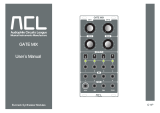
5
EURORACK MX1604A
TABLE OF CONTENTS
1. INTRODUCTION..................................................................................................................... 7
1.1 Architecture .................................................................................................................................... 7
1.2 Before you begin ............................................................................................................................. 8
1.2.1 PSU (Power Supply Unit) ...................................................................................................... 8
1.2.2 Warranty ............................................................................................................................... 8
1.2.3 Packing ................................................................................................................................ 8
1.2.4 Rack mounting the MX1604A ................................................................................................ 8
2. MONO INPUT CHANNEL ....................................................................................................... 8
2.1 Input level setting ............................................................................................................................ 9
2.2 Equalizer ......................................................................................................................................... 9
2.3 Aux Sends ...................................................................................................................................... 9
3. STEREO INPUT CHANNEL ................................................................................................. 10
3.1 Input level setting .......................................................................................................................... 10
3.2 Equalizer ....................................................................................................................................... 10
3.3 Aux Sends .................................................................................................................................... 10
3.4 Routing ......................................................................................................................................... 10
4. MAIN SECTION ..................................................................................................................... 10
4.1 Aux Sends .................................................................................................................................... 10
4.2 Stereo Aux Returns ....................................................................................................................... 10
4.3 Metering ......................................................................................................................................... 11
4.4 Channel mode ................................................................................................................................11
4.5 2-Track input and output ................................................................................................................ 11
4.6 Monitoring ..................................................................................................................................... 12
4.7 Alt 3-4 output ................................................................................................................................ 12
5. SETTING UP ......................................................................................................................... 13
5.1 Desk normalization ....................................................................................................................... 13
5.2 Selecting inputs ............................................................................................................................ 13
5.3 Initializing channels for gain setting ............................................................................................... 13
5.4 Auditioning a signal and setting up a channel ................................................................................13
5.5 Multitrack initialization .................................................................................................................. 14
5.6 Recording levels ............................................................................................................................ 14
5.7 Track sheet ................................................................................................................................... 14
6. APPLICATIONS ..................................................................................................................... 14
6.1 Keyboard mixing, live or in the studio ............................................................................................ 14
6.2 Live gig with simultaneous 2-TK recording ..................................................................................... 15
6.3 Project studio laying vocals to tape ............................................................................................ 16
7. SOME MIXING TOPICS ....................................................................................................... 17
7.1 Equalization .................................................................................................................................. 17
7.2 Gain optimization .......................................................................................................................... 18
8. CONNECTIONS .................................................................................................................... 18
8.1 EURORACK MX1604A connections .............................................................................................. 18
8.2 Connections .................................................................................................................................. 19
8.3 Looming problems ......................................................................................................................... 21




















